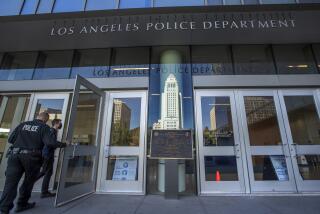In the real world
The emotional heat of the immigration debate finally grew so intense that it opened up several alternate dimensions, where fact evaporates and folklore guides what passes for policy discussion. In one parallel Los Angeles, police officers see violent gang members whom they know to be illegal immigrants but can do nothing to stop them because of a politically correct edict known as Special Order 40. It has become common knowledge in this world that the order doomed young Jamiel Shaw II, the high school student gunned down by an illegal immigrant gang member who roamed the streets with impunity after being released from jail because local law protected him from deportation.
Back in the real world, where fact still holds sway, Special Order 40 had no role in Shaw’s killing. Illegal immigrant and 18th Street Gang member Pedro Espinoza was arrested in November by Culver City police -- not the LAPD -- and jailed on a weapons charge. Espinoza should have been held by U.S. Immigration and Customs Enforcement pending deportation. Instead, he was released, and an innocent and promising high school student was shot to death. The tragedy exposes deplorable failures in the jailhouse processing of illegal immigrant criminals, but it has nothing to do with the LAPD, much less with Special Order 40.
The order was adopted in the late 1970s by then-Chief Daryl F. Gates, hardly a soft-on-crime liberal, who knew that the LAPD would be more effective if undocumented witnesses and victims felt free to speak with officers without fearing deportation. The order prevents officers from questioning people solely to determine their immigration status or arresting them solely for violations of immigration law. It does nothing to stop officers from arresting a violent suspect or calling in federal agents to investigate a person they believe illegally reentered the U.S. after deportation. It was good policy then and remains so today.
But officers often aren’t aware that they’re allowed to call in ICE when they see a criminal they know was deported. The LAPD began clarifying guidelines for officers to comply with the order, but it dropped the effort because it was so politically volatile. This fact opens up yet another parallel universe, one in which denial dictates policy. In this world, it is convenient to ignore that up to 25% of the Los Angeles County jail population is here illegally, or that police and the sheriff could take better advantage of the paltry federal assistance that is offered.
Espinoza escaped federal detection when sent to jail and when released, according to sheriff’s officials, simply by lying when asked where he was born. Any procedure that easy to evade is no procedure at all. When officers don’t know what they can and cannot do, and when other official procedures for protecting the public remain so flimsy, it’s hard to fault critics who incorrectly believe that Special Order 40 lets felons run rampant.
All sides of the immigration debate must reject the folklore about Special Order 40 and get real about removing violent criminals who can and should be deported.
More to Read
Sign up for Essential California
The most important California stories and recommendations in your inbox every morning.
You may occasionally receive promotional content from the Los Angeles Times.










